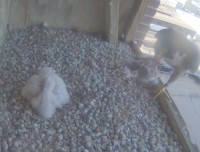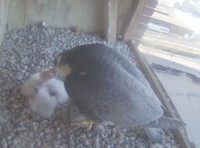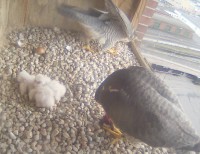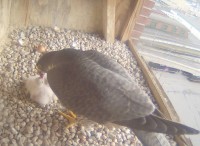Lawrence Peregrine: hatchlings first days!
May 4, 2020 in In the Nest Box, Peregrine Falcons Massachusetts
 What an amazing weekend! Temps neared 80 for many communities yesterday afternoon, with that 78 in Boston, being the warmest day since October 7th of last year. Today, temps step back by about 10 degrees, hovering around 70 early this afternoon. We’ll also have more towering cumulus clouds that build up, producing a few scattered, brief moving showers mid to late afternoon. While most of the day is dry, occasionally the 4 new Peregrine hatchlings may have a passing shower or two in the afternoon! This first photo shows the female returning to the nest with fresh food for the chicks!
What an amazing weekend! Temps neared 80 for many communities yesterday afternoon, with that 78 in Boston, being the warmest day since October 7th of last year. Today, temps step back by about 10 degrees, hovering around 70 early this afternoon. We’ll also have more towering cumulus clouds that build up, producing a few scattered, brief moving showers mid to late afternoon. While most of the day is dry, occasionally the 4 new Peregrine hatchlings may have a passing shower or two in the afternoon! This first photo shows the female returning to the nest with fresh food for the chicks!
 The female was seen brooding and feeding the chicks this morning around 7:30AM. She broods all four chicks. She departs for a few moments and returns with food and she prepares to feed the chicks, while taking a few bites for herself. The female assumes an increasingly elevated brooding position as the chicks grow, and is especially careful with her feet when rising and moving away. The brooding female gently pulls back with the underside of its beak, as needed, one of the small chicks, which moves out from under her, as she might hook a displaced egg. Female attentiveness to brooding depends on weather, the number of nestlings, and their age. Brooding tends to become increasingly sporadic after about the eight day.
The female was seen brooding and feeding the chicks this morning around 7:30AM. She broods all four chicks. She departs for a few moments and returns with food and she prepares to feed the chicks, while taking a few bites for herself. The female assumes an increasingly elevated brooding position as the chicks grow, and is especially careful with her feet when rising and moving away. The brooding female gently pulls back with the underside of its beak, as needed, one of the small chicks, which moves out from under her, as she might hook a displaced egg. Female attentiveness to brooding depends on weather, the number of nestlings, and their age. Brooding tends to become increasingly sporadic after about the eight day.
Literature cited:
Ratcliffe, D. 1993. The Peregrine Falcon. 2nd ed. Carlton, England: T. and A. D. Poyser.


